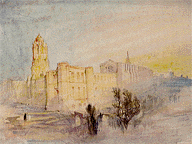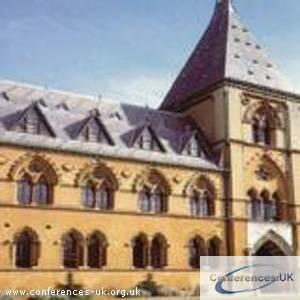Born in 1819, John Ruskin has been known for his contribution to architecture as well as his tenure at Oxford. His portrayal of various features through architecture remains unique to date and has contributed to the body of knowledge embedded in different styles of architecture. As a child, he grew up with good knowledge of art as his father was an avid art collector. This led him to explore his artistic talents through various watercolor paintings, during his undergraduate years at Christ Church in Oxford. This is a period when his literary skills also emerged. Ruskin indulged in writing poetry and doing criticisms of various art and literary work during this time. His friend circle consisted of loud and vivacious characters. A notable feature of this time was that his mother was often with him at Oxford during his undergraduate years. (Landow, 2000).

It was in the year 1842 that John Ruskin came out with his first volume titled Modern Painters. This was followed by an important volume known as The Seven Lamps of Architecture. (Landow, 2000) In this volume, one can find the beginnings of “Ruskinisms” which refers to a certain category of connoisseurship as well as criticism. Ruskinisms defined the elements in architecture that were desirable and those that were grotesque. He did so by providing drawings as well as case studies of various buildings that he criticized. For example, his brand of writing and depicting these elements, or Ruskinisms, was apparent in his volume titled Stones of Venice. (Ruskin, 2003).
Ruskin’s influence on architecture can be all over the world, especially in Oxford where he spent the majority of his years. The Oxford University Museum of Natural History is replete with his portrayals of gothic architecture. In this regard, the structure has been shown as one that has immense scope to improvise upon gothic architecture. Ruskin has shown, through this structure that the gothic brand of architecture is meant to be one that simply shows a modern form of culture by portraying the destructive nature of the Goths, after whom this form of architecture is named. (Ruskin, 1989) The windows in this structure are tall and lavish with ornamentation that consists of features like savage-like qualities as well as fear-invoking elements. The basic theme of this structure is to demonstrate how gothic elements can be modified used to usher in a modern form of expressing culture through art and architecture. This was one of the most successful portrayals of Ruskinisms, as described in his literary work. Based on the elements of Ruskinisms, Ruskin managed to modify a particular brand of architecture to show its most dramatic and grand details, and yet imbibe freshness into the same.

The above picture depicts the details that have been rendered to the structure to portray the gothic style of architecture – one that Ruskin was particularly fond of improvising upon. The windows have a heavy feeling to them, with arched detailing and layers in the same. Further, there is a certain textural quality about the structure in its entirety with domes as well as arches portraying a certain element of strength and power.
Ruskin’s trademark was also seen on various domestic structures in England. There has been a certain social order to the architectural style that has emanated out of the influence of Ruskin’s literary work of the period. Most of the homes in question have shown an affinity for clean lines and detailing in the form of window ornamentations. Further, there is an apparent element of ‘less is more’, with most homes sticking to minimalism in a country house way. There are high ceilings in most of these homes, yet an aura of simplicity adorns these structures with a paucity of pillars and or ornamentation. There is detail in the features like beams, with a certain amount of inclination towards the gothic style. Also, the use of glass in windows, both painted and etched, stands out in these homes due to the plain exteriors. (Harris, 1997) This form of architecture is especially apparent in the Suburban villas that dot the Northern and Southern limits of Oxford. These villas demonstrate a rich quality that in turn shows a refined taste. (Daniels et al, 2003).
Ruskin’s writings and criticisms on architecture – gothic and otherwise – helped notable architects the world over in places like Venice, come up with a more universal twist to the forms of architecture like Gothic, that was typically suited to a certain place. In this way, Ruskin has influenced architecture the world over with notes on what can contribute towards giving a structure a universal appeal that will suit the tastes of generations to come. In this way, he encouraged the radical. In his volume, The Stones of Venice, Ruskin has demonstrated the appeal of gothic architecture and how it might be used for portrayals of various emotions, instead of just fear and darkness. He has managed to bring out a quality in this volume that makes gothic architecture awe-inspiring and desirable with a certain amount of simplicity lent to its grandeur.
With an eye for systematically planned structures, Ruskin found an inclination towards Ecclesiastical architecture. This form of architecture allowed him to explore openness in spaces through the use of symmetry and form. This form of architecture allowed him to practice the theory of statistical calculation for planning spaces. This form of architecture allowed Ruskin to show that architecture needs to deliver a certain theme and intelligent message through its structures – something that he had tried to achieve with gothic architecture.
It was during his tenure as Slade Professor at Oxford, that the Woodstock Road was designed and constructed by Frederick Codd. The features of this work show influences by Ruskin in its paving and boundaries. It showed the world what a modern-day town would look like. With a well-planned structure, it came to become one of the poshest areas for those looking for simple living. In this regard, Ruskin can be compared with Augustus Welby Northmore Pugin, an English architect, and designer. Both were inclined towards Gothic architecture. Yet, Ruskin was more akin to redefining and broadening the horizons of this form of architecture, while Pugin resisted change through his typical medieval portrayals of this style.
Ruskin was a political figure in the sense that his work on politics was revolutionary. His volume titled Six Lectures on Political Economy showed his passion for political writing as well as his knowledge on the subject of politics and economics. This became a benchmark for defining a variety of terms and theories. As a political figure, Ruskin remained a mouthpiece on issues through his writing instead of showing any form of active participation.
In conclusion, it would be imperative to say that John Ruskin was more of a designer and writer in the Victorian and Edwardian eras when architecture was in desperate need of being redefined. He imbibed a bold, yet simple style into this era through his depictions.
References
Landow, George P (2000) Prologue: Ruskin’s Life. A Victorian Web book – Oxford University Press.
A Victorian WebBook. 2007. Web.
Ruskin, J (2003). The Stones of Venice. De Capo Press.
Ruskin, J (1989). The Seven Lamps of Architecture. Dover Publications.
Conferences: UK. The Oxford University Museum of Natural History. 2007. Web.
Harris, Wendell V (1997). Ruskin’s Theoretic Practicality and the Royal Academy’s Aesthetic Idealism. Nineteenth Century Literature, Vol 52, No. 1. (P 80 to 102).
Daniels, R; Brandwood, G (2003). Ruskin and Architecture. Spire Books.